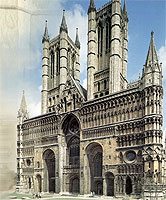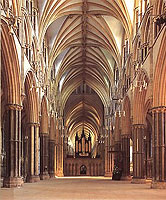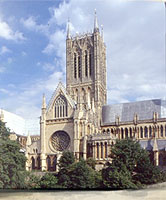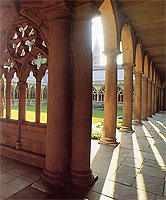The Lincoln Cathedral
The Lincoln Church will double for London's Westminster Abbey ITV reported in May of 2005.
Construction
 Lincoln CathedralWilliam the Conqueror ordered the first cathedral to be built in Lincoln, in 1072; before that, St. Mary's church in Lincoln was a mother church but not a cathedral. Bishop Remigius built the first Lincoln Cathedral on the present site, finishing it in 1092 and then dying two days before it was to be consecrated on May 9 of that year. About fifty years later, most of that building was destroyed in a fire. Bishop Alexander rebuilt and expanded the cathedral, but it was destroyed by an earthquake about forty years later, in 1185, while there was no bishop. The central tower rises to 271 feet and remains the tallest cathedral tower in Europe today without a spire. There was a lead-encased wooden spire that rose 525 feet, that collapsed in 1549 thanks to weather; it was the first building to ever exceed the height of the Great Pyramid of Giza, thereby becoming the world's tallest structure, and remaining that for more than two centuries, until the collapse of the spire. Up to that point in time, the next point on the earths surface at the same height, looking eastwards, was the Ural Mountains in Russia.
Lincoln CathedralWilliam the Conqueror ordered the first cathedral to be built in Lincoln, in 1072; before that, St. Mary's church in Lincoln was a mother church but not a cathedral. Bishop Remigius built the first Lincoln Cathedral on the present site, finishing it in 1092 and then dying two days before it was to be consecrated on May 9 of that year. About fifty years later, most of that building was destroyed in a fire. Bishop Alexander rebuilt and expanded the cathedral, but it was destroyed by an earthquake about forty years later, in 1185, while there was no bishop. The central tower rises to 271 feet and remains the tallest cathedral tower in Europe today without a spire. There was a lead-encased wooden spire that rose 525 feet, that collapsed in 1549 thanks to weather; it was the first building to ever exceed the height of the Great Pyramid of Giza, thereby becoming the world's tallest structure, and remaining that for more than two centuries, until the collapse of the spire. Up to that point in time, the next point on the earths surface at the same height, looking eastwards, was the Ural Mountains in Russia.
History
 Lincoln Cathedral looking inside the central towerKing Henry II of England approved the election of Hugh of Avalon, a Carthusian monk and later canonized a saint, as Bishop of Lincoln in 1186, and St. Hugh died in 1200, before his plan for the rebuilding was completed. The western end of the cathedral was always where it is now, but the eastern end (east of the original, now "great" transept) was moved eastward each time the cathedral was enlarged: The eastern wall of the Norman building (1073) was in the middle of what is now St. Hugh's Choir. The eastern end of the Early English building (1186) was in what is now the Angel Choir behind the High Altar. The existing structure was finished by about 1280, but repairs and remodeling have continued, and there have been repeated problems with the spires (removed in 1807) and towers, which were sometimes thought to be in danger of collapsing, this was despite attempts to shore up the towers by digging underneath them to increase support, an early attempt of what is a common engineering project today on such building as the Leaning Tower of Pisa. Among the persons interred in Lincoln Cathedral are:
Lincoln Cathedral looking inside the central towerKing Henry II of England approved the election of Hugh of Avalon, a Carthusian monk and later canonized a saint, as Bishop of Lincoln in 1186, and St. Hugh died in 1200, before his plan for the rebuilding was completed. The western end of the cathedral was always where it is now, but the eastern end (east of the original, now "great" transept) was moved eastward each time the cathedral was enlarged: The eastern wall of the Norman building (1073) was in the middle of what is now St. Hugh's Choir. The eastern end of the Early English building (1186) was in what is now the Angel Choir behind the High Altar. The existing structure was finished by about 1280, but repairs and remodeling have continued, and there have been repeated problems with the spires (removed in 1807) and towers, which were sometimes thought to be in danger of collapsing, this was despite attempts to shore up the towers by digging underneath them to increase support, an early attempt of what is a common engineering project today on such building as the Leaning Tower of Pisa. Among the persons interred in Lincoln Cathedral are:
 Lincoln Cathedral and its bishops have also had a leading role in the history of England. Most importantly is the Magna Carta which was signed by the Bishop of Lincoln amongst others, and what is one of only two copies resides in the cathedral's library although it is lent out to American museums to raise funds, a problem the diocese has suffered ever since the reformation. With more monasteries than everywhere else in England put together in Lincolnshire alone and a vast number in other lands controlled by the diocese the reformation cut off the main source of income to the Cathedral leaving the massive structure under the care of an organisation that can barely support it.
Lincoln Cathedral and its bishops have also had a leading role in the history of England. Most importantly is the Magna Carta which was signed by the Bishop of Lincoln amongst others, and what is one of only two copies resides in the cathedral's library although it is lent out to American museums to raise funds, a problem the diocese has suffered ever since the reformation. With more monasteries than everywhere else in England put together in Lincolnshire alone and a vast number in other lands controlled by the diocese the reformation cut off the main source of income to the Cathedral leaving the massive structure under the care of an organisation that can barely support it.
The Lincoln Imp
One of the stone gargoyles within the Cathedral is the Lincoln Imp, of which there are several variations of the legend surrounding the figure. The general gist of the story is that the Imp was sent by Satan to cause mayhem in the cathedral, but was challenged and ordered to stop by an Angel, in the Angel Choir. The Imp laughed, sat on a stone pillar and threw rocks the the Angel, so the Angel turned the Imp to stone, and he is there today, sitting on the same stone pillar in the Angel Choir.
Today
 A close up of some of the severely eroded stonework on Lincoln CathedralOver £1 million a year is spent on keeping the cathedral in shape, the most recent project completed has been the restoration of the West Front in 2000. About 10 years ago it was discovered that the Flying Buttresses on the east end were no longer connected to the adjoining stonework, and hasty repairs had to be made.
A close up of some of the severely eroded stonework on Lincoln CathedralOver £1 million a year is spent on keeping the cathedral in shape, the most recent project completed has been the restoration of the West Front in 2000. About 10 years ago it was discovered that the Flying Buttresses on the east end were no longer connected to the adjoining stonework, and hasty repairs had to be made.
The problems arise because the building techniques used were groundbreaking at the time, and the builders were literally making it up as they went along. It was not unknown for newly built parts to collapse shortly afterwards, as they learned the techniques and methods needed to build in this style. Remember, up to this point, there were only Norman churches, which were short, dark, and with thick walls and small windows. The introduction of Gothic style made churches bright and spacious, but they were writing the rule book at the same time, and it was literally trial and error.
Worryingly though, parts of the ceiling of the nave have started to fall requiring green netting to be slung under it to catch any pieces as the only alternative to shutting the cathedral. The outside has fared little better as tourists have had to dodge pieces of falling masonry creating the need for urgent repairs of some decayed stonework.
The central window in the quire, is in danger of falling out and the supporting stonework around it held up only by connecting metal struts fixed diagonally to the ground. A similar fate is threatened for the Dean's Eye window in the north transept, dating from 1220, still with much of its original mediaeval glass depicting the Last Judgement, but patched over the years with a metal frame to stop it also falling out.
Despite the problems Lincoln Cathedral remains much loved and is visited by over 250,000 tourists a year. The peak of its season are the Lincoln Christmas Market and a massive annual production of Handels 'the Messiah'
Construction
 Lincoln CathedralWilliam the Conqueror ordered the first cathedral to be built in Lincoln, in 1072; before that, St. Mary's church in Lincoln was a mother church but not a cathedral. Bishop Remigius built the first Lincoln Cathedral on the present site, finishing it in 1092 and then dying two days before it was to be consecrated on May 9 of that year. About fifty years later, most of that building was destroyed in a fire. Bishop Alexander rebuilt and expanded the cathedral, but it was destroyed by an earthquake about forty years later, in 1185, while there was no bishop. The central tower rises to 271 feet and remains the tallest cathedral tower in Europe today without a spire. There was a lead-encased wooden spire that rose 525 feet, that collapsed in 1549 thanks to weather; it was the first building to ever exceed the height of the Great Pyramid of Giza, thereby becoming the world's tallest structure, and remaining that for more than two centuries, until the collapse of the spire. Up to that point in time, the next point on the earths surface at the same height, looking eastwards, was the Ural Mountains in Russia.
Lincoln CathedralWilliam the Conqueror ordered the first cathedral to be built in Lincoln, in 1072; before that, St. Mary's church in Lincoln was a mother church but not a cathedral. Bishop Remigius built the first Lincoln Cathedral on the present site, finishing it in 1092 and then dying two days before it was to be consecrated on May 9 of that year. About fifty years later, most of that building was destroyed in a fire. Bishop Alexander rebuilt and expanded the cathedral, but it was destroyed by an earthquake about forty years later, in 1185, while there was no bishop. The central tower rises to 271 feet and remains the tallest cathedral tower in Europe today without a spire. There was a lead-encased wooden spire that rose 525 feet, that collapsed in 1549 thanks to weather; it was the first building to ever exceed the height of the Great Pyramid of Giza, thereby becoming the world's tallest structure, and remaining that for more than two centuries, until the collapse of the spire. Up to that point in time, the next point on the earths surface at the same height, looking eastwards, was the Ural Mountains in Russia.History
 Lincoln Cathedral looking inside the central towerKing Henry II of England approved the election of Hugh of Avalon, a Carthusian monk and later canonized a saint, as Bishop of Lincoln in 1186, and St. Hugh died in 1200, before his plan for the rebuilding was completed. The western end of the cathedral was always where it is now, but the eastern end (east of the original, now "great" transept) was moved eastward each time the cathedral was enlarged: The eastern wall of the Norman building (1073) was in the middle of what is now St. Hugh's Choir. The eastern end of the Early English building (1186) was in what is now the Angel Choir behind the High Altar. The existing structure was finished by about 1280, but repairs and remodeling have continued, and there have been repeated problems with the spires (removed in 1807) and towers, which were sometimes thought to be in danger of collapsing, this was despite attempts to shore up the towers by digging underneath them to increase support, an early attempt of what is a common engineering project today on such building as the Leaning Tower of Pisa. Among the persons interred in Lincoln Cathedral are:
Lincoln Cathedral looking inside the central towerKing Henry II of England approved the election of Hugh of Avalon, a Carthusian monk and later canonized a saint, as Bishop of Lincoln in 1186, and St. Hugh died in 1200, before his plan for the rebuilding was completed. The western end of the cathedral was always where it is now, but the eastern end (east of the original, now "great" transept) was moved eastward each time the cathedral was enlarged: The eastern wall of the Norman building (1073) was in the middle of what is now St. Hugh's Choir. The eastern end of the Early English building (1186) was in what is now the Angel Choir behind the High Altar. The existing structure was finished by about 1280, but repairs and remodeling have continued, and there have been repeated problems with the spires (removed in 1807) and towers, which were sometimes thought to be in danger of collapsing, this was despite attempts to shore up the towers by digging underneath them to increase support, an early attempt of what is a common engineering project today on such building as the Leaning Tower of Pisa. Among the persons interred in Lincoln Cathedral are:- St. Hugh of Avalon, in the Angel Choir
- Richard Fleming, (died 1431), Bishop of Lincoln, in the first cadaver tomb ever, in a chantry on the north wall. His moldering corpse is realistically depicted below his effigy.
- Katherine Swynford and her daughter Joan Beaufort, in a chantry on the south side of the sanctuary
 Lincoln Cathedral and its bishops have also had a leading role in the history of England. Most importantly is the Magna Carta which was signed by the Bishop of Lincoln amongst others, and what is one of only two copies resides in the cathedral's library although it is lent out to American museums to raise funds, a problem the diocese has suffered ever since the reformation. With more monasteries than everywhere else in England put together in Lincolnshire alone and a vast number in other lands controlled by the diocese the reformation cut off the main source of income to the Cathedral leaving the massive structure under the care of an organisation that can barely support it.
Lincoln Cathedral and its bishops have also had a leading role in the history of England. Most importantly is the Magna Carta which was signed by the Bishop of Lincoln amongst others, and what is one of only two copies resides in the cathedral's library although it is lent out to American museums to raise funds, a problem the diocese has suffered ever since the reformation. With more monasteries than everywhere else in England put together in Lincolnshire alone and a vast number in other lands controlled by the diocese the reformation cut off the main source of income to the Cathedral leaving the massive structure under the care of an organisation that can barely support it.The Lincoln Imp
One of the stone gargoyles within the Cathedral is the Lincoln Imp, of which there are several variations of the legend surrounding the figure. The general gist of the story is that the Imp was sent by Satan to cause mayhem in the cathedral, but was challenged and ordered to stop by an Angel, in the Angel Choir. The Imp laughed, sat on a stone pillar and threw rocks the the Angel, so the Angel turned the Imp to stone, and he is there today, sitting on the same stone pillar in the Angel Choir.
Today
 A close up of some of the severely eroded stonework on Lincoln CathedralOver £1 million a year is spent on keeping the cathedral in shape, the most recent project completed has been the restoration of the West Front in 2000. About 10 years ago it was discovered that the Flying Buttresses on the east end were no longer connected to the adjoining stonework, and hasty repairs had to be made.
A close up of some of the severely eroded stonework on Lincoln CathedralOver £1 million a year is spent on keeping the cathedral in shape, the most recent project completed has been the restoration of the West Front in 2000. About 10 years ago it was discovered that the Flying Buttresses on the east end were no longer connected to the adjoining stonework, and hasty repairs had to be made.The problems arise because the building techniques used were groundbreaking at the time, and the builders were literally making it up as they went along. It was not unknown for newly built parts to collapse shortly afterwards, as they learned the techniques and methods needed to build in this style. Remember, up to this point, there were only Norman churches, which were short, dark, and with thick walls and small windows. The introduction of Gothic style made churches bright and spacious, but they were writing the rule book at the same time, and it was literally trial and error.
Worryingly though, parts of the ceiling of the nave have started to fall requiring green netting to be slung under it to catch any pieces as the only alternative to shutting the cathedral. The outside has fared little better as tourists have had to dodge pieces of falling masonry creating the need for urgent repairs of some decayed stonework.
The central window in the quire, is in danger of falling out and the supporting stonework around it held up only by connecting metal struts fixed diagonally to the ground. A similar fate is threatened for the Dean's Eye window in the north transept, dating from 1220, still with much of its original mediaeval glass depicting the Last Judgement, but patched over the years with a metal frame to stop it also falling out.
Despite the problems Lincoln Cathedral remains much loved and is visited by over 250,000 tourists a year. The peak of its season are the Lincoln Christmas Market and a massive annual production of Handels 'the Messiah'
0 Comments:
Post a Comment
<< Home